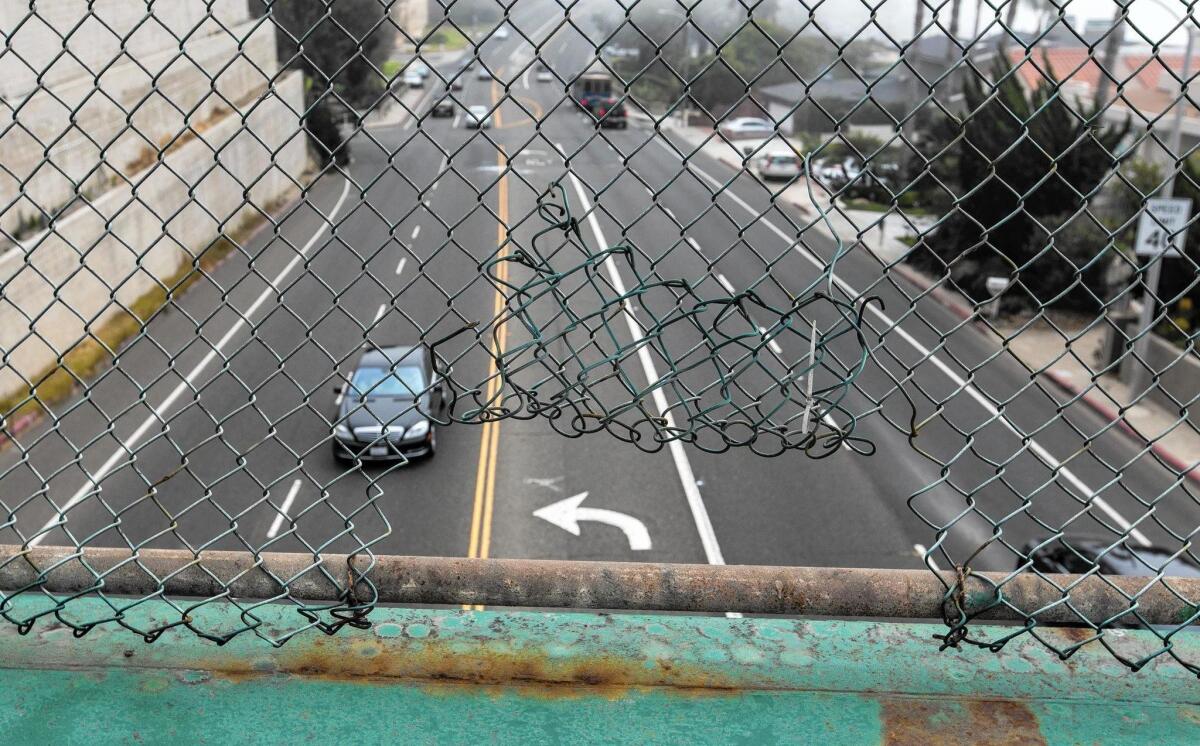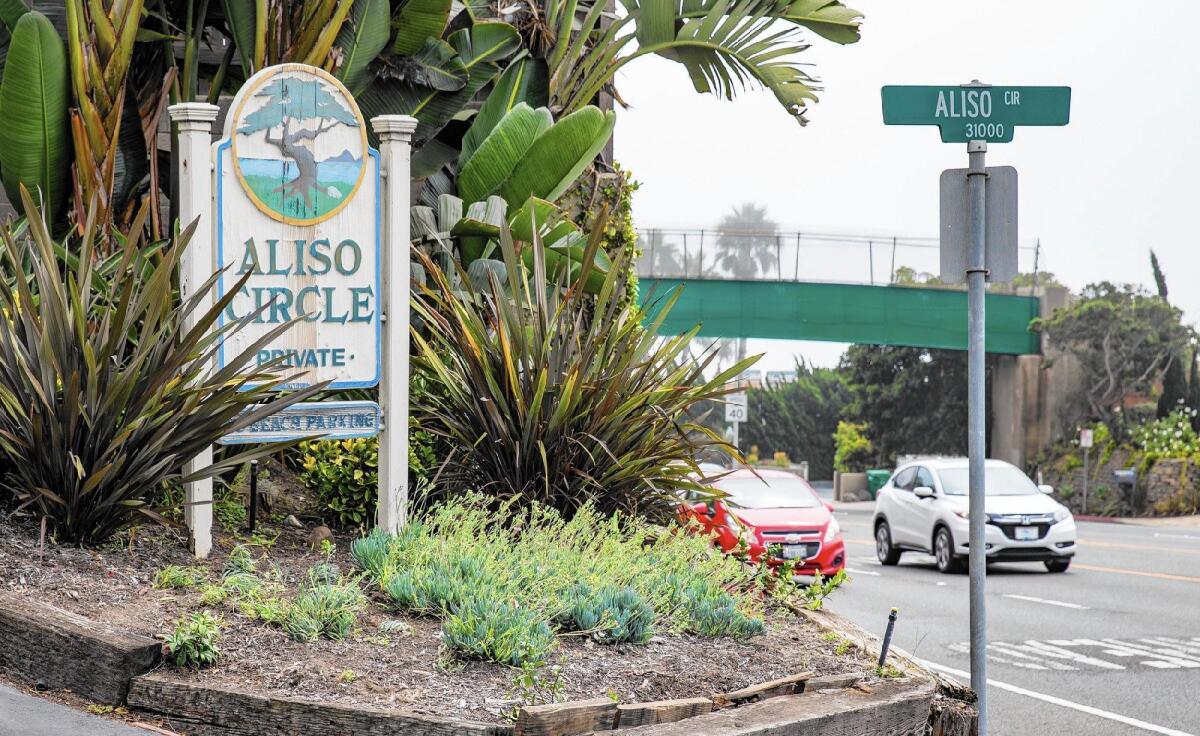A small bridge signifies a fading memory

There’s an old, faded swastika that adorns the pedestrian bridge walkway, which is rarely used.
- Share via
Bridges are normally majestic and purposeful and often artistic.
In Laguna Beach, however, the only real bridge in town is none of that.
It’s dowdy, pointless and, quite frankly, ugly.
You’ve probably passed by it hundreds of times on Coast Highway above Aliso Beach and never gave it much thought. That’s because it excels at being forgettable.
It’s an inexplicable hunk of green metal and concrete that is maintained by the state. You can tell the state manages it because it’s the same dull green color that Caltrans uses on road signs — PMS 342, to be exact.

The safety fence on the pedestrian bridge is starting to show its age.
So where did this bridge come from? Why? And more importantly, in a city that can’t even build sidewalks along Coast Highway, how can a useless bridge get built?
Well, here’s the story.
I didn’t know these things either so I started by walking into the Laguna Beach Historical Society on Sunday. A friendly docent named Jane Storck admitted she did not know the answers but would help me find out.
She immediately emailed her historical colleagues, and by Monday I was talking to Ann Christoph, who it turns out used to live by the bridge and knew about its origins.
“It’s an interesting story, I think, how it happened and why it’s there,” she said.

The old pedestrian bridge, in the background, only serves the private Aliso Circle community.
Calling it “a small, undiscovered asset,” Christoph said, beginning at the beginning — as in, the beginning of Laguna.
She explained who owned the nearby properties back in the late 1800s and early 1900s. All of this will become relevant later.
As always, it was about who owned what, where and how to get to the beach. Back then, of course, the California Coastal Commission did not exist.
“The Thurston homestead cut across in a straight east-west line across the back of what is Aliso Circle now,” she said. “And also that went all the way to the row of single-family houses on the ocean side of the highway. So at the end of the Montage property, that was a different homestead. That was the Goff homestead, and south of the Montage property line, that was the Thurston homestead, roughly.”
These property lines became important for a couple of reasons. By 1926, Coast Highway would be built, and it did not always follow the existing dirt road.
In fact, there was a bridge that went over Aliso Creek, but it wasn’t at its current location.
“If you look at those old William Wendt paintings, he paints a bridge that’s further up the canyon — a much smaller, much lower bridge,” Christoph said. “And then the road eased back again towards the ocean and went to that trail that is up behind the telephone company now.”

Within the Aliso Circle community, the path to the bridge is behind a gate and difficult to find.
It was during these negotiations with the state that Joe Thurston became concerned.
“When the Department of Transportation wanted to build Coast Highway, Thurston wanted them to do an elevated bridge, kind of like they do along Highway 1 in the Big Sur area,” she said. “He objected to the cutting that was going to be done in those bluffs on both sides. But the worst of the cutting is on the south side. So those cliffs are not natural cliffs on the south side.”
Upset at the imminent destruction of the bluffs, Thurston sued the state and county. But he ultimately lost.
“But he went very far to try and protect that land from that he thought was so important, and I tend to agree with him,” she said. “So I’m not sure if it was part of the settlement or because of all the fuss he’d made, but he objected that the land that was going to become Aliso Circle was going to be cut off from the beach. And so the state built the pedestrian bridge.”
One man — albeit an influential landowner — tackled with the state and got a bridge.
For years the bridge was functional because there was a nearby school on the east side of the road and a trailer park where the Montage was eventually built.
But over time all that changed.
Now, the bridge is hardly used at all, except for the few in the private and very small Aliso Circle community.
Or once in a while, someone will go up and hang a political banner for passing motorists.
The bridge itself is standing but it’s not in great shape. The safety fencing is broken in places; the steps are starting to crumble, and there’s been some unfortunate graffiti.
For a rare bridge that spans Coast Highway, leading to the world’s birthplace of skimboarding, it’s a disappointing experience.
And there’s really not much to do about it.
More than anything, it creates problems at this point. The city can’t build sidewalks there because the abutments are too close together, creating a hazard.
Preservationists would probably go ballistic if anyone suggested just tearing it down.
Instead, we have an anachronistic symbol of political compromise, born of an ancient land-use dispute, benefiting no one today.
So there you have it — a bridge that died many years ago.
---
DAVID HANSEN is a writer and Laguna Beach resident. He can be reached at hansen.dave@gmail.com.
More to Read
Sign up for Essential California
The most important California stories and recommendations in your inbox every morning.
You may occasionally receive promotional content from the Los Angeles Times.













